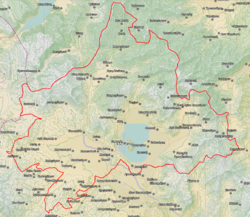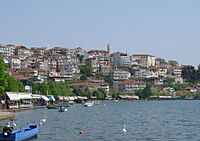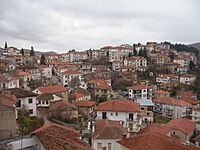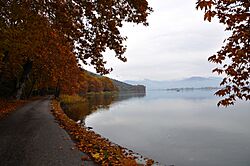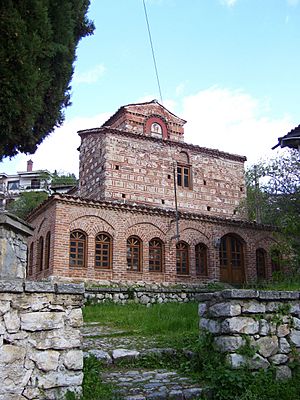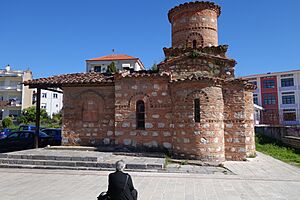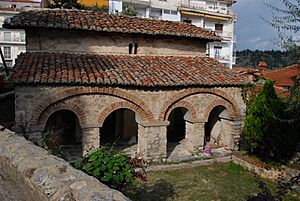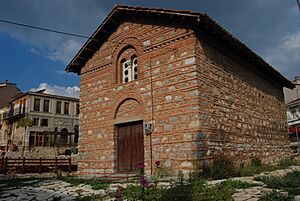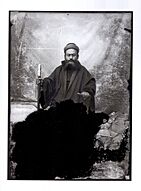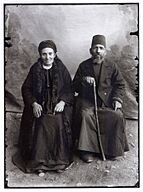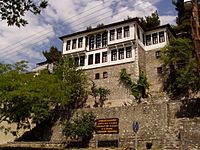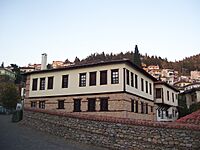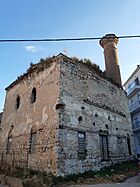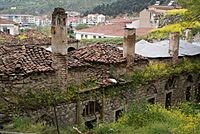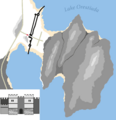Kastoria facts for kids
Quick facts for kids
Kastoria
Καστοριά
|
|
|---|---|

Kastoria and Lake Orestiada.
|
|
| Country | Greece |
| Geographic region | Macedonia |
| Administrative region | Western Macedonia |
| Regional unit | Kastoria |
| Area | |
| • Municipality | 763.3 km2 (294.7 sq mi) |
| • Municipal unit | 57.3 km2 (22.1 sq mi) |
| Elevation | 700 m (2,300 ft) |
| Population
(2021)
|
|
| • Municipality | 33,095 |
| • Municipality density | 43.358/km2 (112.296/sq mi) |
| • Municipal unit | 16,393 |
| • Municipal unit density | 286.09/km2 (741.0/sq mi) |
| Demonym(s) | Kastorian Kastorianos (Greek) |
| Time zone | UTC+2 (EET) |
| • Summer (DST) | UTC+3 (EEST) |
| Postal code |
521 00
|
| Area code(s) | 24670 |
| Vehicle registration | KT |
Kastoria (Greek: Καστοριά, Kastoriá [kastoˈrʝa]) is a city in northern Greece in the region of Western Macedonia. It is the capital of Kastoria regional unit, in the geographic region of Macedonia. It is situated on a promontory on the western shore of Lake Orestiada, in a valley surrounded by limestone mountains. The town is known for its many Byzantine churches, Byzantine and Ottoman-era domestic architecture, its lake and its fur clothing industry.
Contents
Name
The city is first mentioned in 550 AD, by Procopius as follows: "There was a certain city in Thessaly, Diocletianopolis by name, which had been prosperous in ancient times, but with the passage of time and the assaults of the barbarians it had been destroyed, and for a very long time it had been destitute of inhabitants; and a certain lake chances to be close by which was named Castoria. There is an island in the middle of the lake, for the most part surrounded by water; but there remains a single narrow approach to this island through the lake, not more than fifteen feet wide. And a very lofty mountain stands above the island, one half being covered by the lake while the remainder rests upon it." Although Procopius refers to it as "a city of Thessaly", the description is undoubtedly that of Kastoria, a city on a promontory in a lake.
There are several theories about the origin of the name Kastoria. The dominant of these is that the name derives from the Greek word κάστορας (kástoras, meaning "beaver"). Trade in the animal's fur, sourced from nearby Lake Orestiada, has traditionally been an important element of the city's economy. Other theories propose that the name derives from the Greek word κάστρο (kástro, meaning "castle"; from the Latin word castrum) or from the mythical hero Κάστωρ (Kástōr), who may have been honoured in the area. The word is sometimes written with a C, Castoria, especially in older works. From Greek, the name was borrowed into Turkish as Kesriye. The Bulgarian, Macedonian and Serbian name of the city is Kostur (Cyrillic: Костур). The Albanian name is Kosturi, while the Aromanian name is Castoria.
Municipality
The municipality Kastoria was formed at the 2011 local government reform by the merger of the following 9 former municipalities, that became municipal units:
- Agia Triada
- Agioi Anargyroi
- Kastoria
- Kastraki
- Kleisoura
- Korestia
- Makednoi
- Mesopotamia
- Vitsi
The municipality has an area of 763.330 km2, the municipal unit 57.318 km2. The municipal unit consists of the town Kastoria and the settlements Aposkepos, Kefalari and Chloi.
Districts
- Apózari
- Doltsó
- Dailaki (Myloi)
- Doplitsa
- Kato Agora
- Kallithea
- Lyv
Main streets
- Palaiologou Street
- Nikis Avenue
- Christopoulou Street
- Kyknon Avenue
- Orestion
- Orestiados
- Megalou Alexandrou
- Kapodistria
- Ifaistou
Climate
Kastoria has a humid subtropical climate (Cfa). As a result of the moderating effect of the lake, it records less extreme temperatures than the rest of Western Macedonia.
| Climate data for Kastoria city (623m) | |||||||||||||
|---|---|---|---|---|---|---|---|---|---|---|---|---|---|
| Month | Jan | Feb | Mar | Apr | May | Jun | Jul | Aug | Sep | Oct | Nov | Dec | Year |
| Mean daily maximum °C (°F) | 7.2 (45.0) |
11.8 (53.2) |
14.7 (58.5) |
17.3 (63.1) |
23.3 (73.9) |
27.8 (82.0) |
30.4 (86.7) |
31.3 (88.3) |
26.4 (79.5) |
19.6 (67.3) |
13.9 (57.0) |
9.2 (48.6) |
19.4 (66.9) |
| Mean daily minimum °C (°F) | −1.1 (30.0) |
0.8 (33.4) |
3 (37) |
6 (43) |
10.2 (50.4) |
14.3 (57.7) |
16.9 (62.4) |
16.9 (62.4) |
13.5 (56.3) |
8.6 (47.5) |
5.8 (42.4) |
2.8 (37.0) |
8.1 (46.6) |
| Average precipitation mm (inches) | 50 (2.0) |
54 (2.1) |
61 (2.4) |
79 (3.1) |
81 (3.2) |
48 (1.9) |
40 (1.6) |
31 (1.2) |
46 (1.8) |
66 (2.6) |
65 (2.6) |
40.5 (1.59) |
661.5 (26.09) |
| Source: 2019–2021 averages and precipitation | |||||||||||||
History
Antiquity
Kastoria is believed to have ancient origins. Livy (XXXI, XL) mentions a town near a lake in Orestis, called Celetrum, whose inhabitants surrendered to Sulpitius during the Roman war against Philip V of Macedon (200 BC). The ancient town was possibly located on a hill above the town's current location.
The Roman Emperor Diocletian (ruled 284–305 AD) founded the town of Diocletianopolis (Διοκλητιανούπολις) in the vicinity. Procopius (De aedificiis, 4.3.1–4) relates that, after Diocletianopolis was destroyed by barbarians, Emperor Justinian relocated it on a promontory projecting into Lake Orestiada, the town's current location, and "gave it an appropriate name", perhaps indicating that he renamed it Justinianopolis (Ίουστινιανούπολις). Th. L. Fr. Tafel, in his study on the Via Egnatia (De via militari Romanorum Egnatia, 1832), suggested that Celetrum, Diocletianopolis and Kastoria are three successive names of the same place. A Jewish community resided in the town.
Middle Ages
Kastoria itself does not appear, however, until the Byzantine–Bulgarian wars of the late 10th/early 11th century (the mention of Diocletianopolis in Constantine Porphyrogennetos' De Thematibus is anachronistic, drawing from the 6th-century Synecdemus). The town was in Bulgarian hands until 1018, when it was conquered by Basil II.
Kastoria was occupied by the Normans under Bohemond I in 1082/83. In October 1083, emperor Alexios I Komnenos forced the garrison to surrender, recovering thus the town and convincing many Norman troops, including Peter Aliphas, to enter his services.
During the 13th and 14th centuries, the town became contested between several powers and changed hands often. The Second Bulgarian Empire held the city under Kaloyan and Ivan Asen II. Under the Bulgarians, Kastoria had a significant Romaniote Jewish community, with prominent individuals such as scholar Tobiah ben Eliezer.
Later, it was recovered by the Despotate of Epirus. The Nicaean Empire captured it in ca. 1252, but lost it again to Epirus in ca. 1257, only for the Nicaeans to recapture it following the Battle of Pelagonia (1259).
In the early 14th century, Kastoria was part of the domain of John II Doukas, "doux of Great Vlachia and Kastoria". After his death, the town became part of the semi-autonomous domain of Stephen Gabrielopoulos. After the latter's death in 1332/3, the Byzantine emperor Andronikos III Palaiologos took over the town, but in the very next year (1334) it was surrendered briefly to the Serbs by the renegade Syrgiannes Palaiologos.
The Serbian ruler Stephen Dushan finally captured Kastoria in 1342/3, taking advantage of the ongoing Byzantine civil war, and made it part of his Serbian Empire. After Dushan's death, Kastoria became the seat of Symeon Uroš.
The town came later under the Epirote ruler Thomas Preljubović, and briefly under the Albanian Muzaka family, until it was conquered by the Ottoman Empire in the mid-1380s.
Ottoman era
The Ottoman Turks conquered Kastoria around 1385, but it is unclear whether by force or by an agreement with its Albanian rulers. The Ottoman fiscal register of 1445 showed a total population of 4,518, of which 3,977 were Chritians, 431 were Jews, and 110 were Muslims. Following the conquest and depopulation of Constantinople, Romaniote Jews from Kastoria led by Matthia Tamar were forcefully resettled by the Ottomans in Balat district as part of efforts to repopulate the city. A synagogue named after Kastoria was built and still stands in modern Istanbul.
In 1519, the town had 4,815 people, of which 4,480 were Christians and 335 were Muslims, divided into 732 Christian households and 67 Muslim households; it was a zeamet of Chamberlain Mehmed Bey, and the infantry commander of Thessaloniki, Hızır. The town also had Voynuks. Muslims were a minority in Kastoria, and would remain a minority for the duration of Ottoman rule.
The establishment of Ottoman rule resulted in the demise of the local Greek landowning class, and funding of the arts and culture in Kastoria was undertaken by its wealthy merchants. The Greek merchants Georgios Kyritses and Manolakis Kastorianos financed Greek education in Kastoria. Greek schools were established in Kastoria, with the oldest in the town and Macedonia being founded in 1614; a second was founded in 1705, and a third in 1715, funded by Kyritses.
In the late seventeenth century, the Jewish messianic Sabbatean movement had some prominent supporters in Kastoria, although most remained as practising Jews. Jews with Italian and Spanish origins from Vlorë, later went to Berat and left after several epidemics and resettled in Kastoria by 1740. In 1797–1798, the Greek revolutionary Rigas Feraios was partly based in Kastoria.
In the late Ottoman period, Kastoria was the seat of a kaza belonging to the sanjak of Görice, within the Vilayet of Monastir. Ladino speaking Jews immigrated to the United States and by the early twentieth century those from Kastoria had formed a Kastoria Society. In the modern period the community still uses the name Kastoria for burial plots. Under Ottoman rule, the Jews of Kastoria had close ties with the Jewish community of Monastir (modern Bitola). In the early twentieth century, the Kastorian Jews were Sephardim and numbered some 1,600. In Kastoria, the Jewish community had a chief rabbi, three yeshivot (Jewish religious schools), and several synagogues.
According to the findings of Vasil Kanchov, at the turn of the 20th century, the town had 3,000 Greek Christians, 1,600 Turkish Muslims, 750 Jews, 300 Bulgarian Christians, 300 Albanian Christians, and 240 Roma, for a total of 6190 inhabitants. According to the findings of Dimitri Mishev, the town had a population of 4,000 Greek Christians, 400 Bulgarian Patriarchist Grecomans and 72 Vlachs in 1905 (excluding the Muslim minority).
The older presence of Greek cultural tradition led to the establishment of strong Greek national feeling among town inhabitants in an era of conflict arising from nationalism (late 19th and early 20th centuries). As a result, Kastoria became the main location for the Greek movement in west Macedonia during this period.
Macedonian Struggle and Balkan Wars

As a largely Greek town in west Macedonia at the turn of the 20th century, Kastoria featured prominently in the Greek efforts during the Macedonian Struggle. A notable figure was Germanos Karavangelis, who served as the Greek Orthodox Metropolitan Bishop of Kastoria from 1900 until 1907. For Karavangelis, the post-Ottoman future of Macedonia would be decided by Balkan states and viewed Greek interests threatened by Bulgarian influence in the area. He formed the earliest Greek armed groups fighting for the region. During the Macedonian struggle, Karavangelis, an imposing figure travelled in rural areas and directed the Greek response toward supporters of the Bulgarian cause, the Internal Macedonian Revolutionary Organization (VMRO) and the Exarchate. He supported close interaction among local Turks and Greeks, only when it was needed. Greece sent more funds, men and arms to individuals such as Karavangelis in Macedonia.
Ottoman rule ended in Kastoria after it was taken by the Greek Army in the First Balkan War (1912). In 1913, the town was annexed and the treaties of London and Bucharest formally recognised Kastoria and the wider area as part of Greece.
Interwar period
The 1920 Greek census recorded 6,280 people in the town, and 829 inhabitants (242 families) were Muslim in 1923. The Muslim population of Kastoria during the Greek–Turkish population exchange (1923) was sent to Turkey, and resettled in places such as Bor, Kahramanmaraş, and Yozgat. In Kastoria, Greek refugee families were from East Thrace (19), Asia Minor (101) and Pontus (1) in 1926. The 1928 Greek census recorded 10,308 town inhabitants. In 1928, the refugee families numbered 137 (588 people) in 1928.
In 1928, Kastorian Jews numbered 1,000. Zionist groups were present in Kastoria and some of its Jewish children were sent to study in Mandate Palestine.
World War II
During both World War II and the Greek Civil War, the town was repeatedly fought over and heavily damaged in the process. It was nearly captured by the Communist Democratic Army of Greece in 1948, and the final battles of the civil war took place on the nearby Mount Gramos in 1949.
In World War Two, Kastoria and its Jewish population came under Italian occupation. The Jewish community numbered 900 people in 1940 and 1943. In 1943, the judicial courts of Kastoria were destroyed by fire, including the town archive. Italy surrendered in late 1943, and Kastoria came under German control. In late March 1944, 763 Kastorian Jews were taken prisoner and during April 1943 the German army sent them first to Thessaloniki and later to the Auschwitz concentration camp where they were gassed. In 1945, the Kastoria Jewish community numbered 35 people, a reduction of 95 percent due to the Holocaust.
Kastoria was liberated by the guerrillas of the Greek People's Liberation Army.
Modern period
Following the Greek Civil War, large numbers of Kastorian Greeks migrated abroad, where in the 1980s they numbered 25,000 in the New York area, and worked as furriers; younger generations worked as lawyers and doctors. A Kastorian Greek diaspora numbering 10,000 in the 1980s established itself in Frankfurt after it replaced Leipzig as Germany's new fur industry centre, following its post–war division.
The Jewish population of Kastoria was 38 in 1948, 27 in 1959, two in 1973 and five in 1983. Post war, heirless Jewish properties of Kastoria were 22 dwellings, three shops and 35 land lots and were administered by the OPAIE (The Heirless Property and Jewish Rehabilitation Fund). In the early 1970s, the Central Board of Jewish Communities, an organisation representing Jewish communities in Greece, attempted to liquate Jewish properties in Kastoria with support from a few local Jews, several other Kastorians and officials. The Kastoria Jewish diaspora in Israel and the US supported moves to reclaim the properties. The Central Board managed to gain control of a few communal properties after purchasing them from their Jewish owners. The Jewish community had dwindled to one family and during the 1980s, relatives and business were factors which influenced Jews to remain in Kastoria. By the late twentieth century the Jewish presence in Kastoria had disappeared due to deaths and migration. Members from the Kastorian Jewish diaspora produced Trezoros: The Lost Jews of Kastoria, a documentary about the Jews of Kastoria.
Economy
Kastoria is a popular tourist destination and an international centre of fur trade, having taken so the nickname the city of the fur traders. Tourism and the fur industry dominate the local economy. Indeed, (as mentioned above) the town was possibly named after one of the former staples of the trade – the European beaver (kastóri in Greek), now extinct in the area. Trading in mink fur now predominates and every year an international showcase of fur takes place in the city.
Involvement with fur began in the early middle ages, when Kastoria supplied ermine pelts for the robes of Byzantine courtiers. The fur industry was established in Kastoria during the sixteenth century, and extensive trade links emerged connecting the town with wider Europe. Merchants settled in Germany and Russia. In the seventeenth century, Kastoria was the European fur industry centre and marketplace, and various fur products on offer were imports (such as pelts from Russian sable), with a majority of Kastorian Jews being wealthy dealers in the fur trade. By the late 18th century, Kastoria had developed a strong Hellenic commercial culture.
In Kastoria, the Jewish community was involved in the fur industry, and its merchants worked closely with craftsmen who were mainly from the Greek community. The town economy was successful, in particular during the nineteenth century, due to both Jews and Greeks working well together. Slavophone peasants from the wider area would go to Kastoria on market days. By the early twentieth century, Jewish merchants were involved in the trade of fur and tobacco. The Muslim population of Kastoria in 1913 worked as fishermen (30 percent) in Lake Kastoria, in agriculture (13 percent), or were large landowners (16 percent). In the interwar period, local Jews were involved in the textile, agricultural, and raw material sectors of Kastoria's economy.
In modern Kastoria, there are more than 300 small and big dealers in fur. Abroad, early twentieth century immigration to New York from Kastoria by Greeks involved in fur production expanded the local US industry, as demand for fur clothing increased, with most small businesses owned by Kastorian Greeks. The modern fur industry in New York is run by Kastorian Greeks, such as Castor Furs; a business involved in the fashion industry. Other industries include the sale and distribution of locally grown produce; particularly wheat, apples, wine, and fish. Recently a large shopping center has been built in the city of Kastoria. Kastoria has 16 local radio stations, two TV stations, five daily newspapers, and seven weekly ones. The town's airport is named Aristotelis Airport.
Landmarks
Byzantine monuments
Kastoria is an important religious centre for the Greek Orthodox Church and is the seat of a metropolitan bishop. The Metropolis of Kastoria is one of the metropolises of the New Lands in Greece, administered as part of the Church of Greece. Kastoria originally had 72 Byzantine and medieval churches, of which 54 have survived, including Panagia Koumpelidiki and St Athanasius of Mouzaki. Some of these have been restored and provide useful insight into trends in Late Byzantine styles of architecture and fresco painting.
The Museum of Byzantine History located on Dexamenis Square houses many examples of Byzantine iconography. The Costume Museum and the Monuments Museum are also located in the city.
Doltsó and Apózari
During the Ottoman times, Kastoria attracted a multitude of people from across the Balkans and beyond, resulting in a diverse, multi-ethnic community. As a result, the city plan was radically transformed. The different ethnic communities, Bulgarian, Turkish, Greek, and Jewish, became centred around separate neighbourhoods or 'quarters'. Two old Greek lakeside quarters, the "Doltso" (Dolcho) and "Apozari" neighbourhoods, are among the best-preserved and last remaining traditional quarters of the city.
These neighbourhoods are characterised by the rich stock of old houses preserved in the shape of autonomous historic buildings, such as the important private mansions or the more humble folk dwellings ('accessory' buildings) built between the 17th and 19th centuries. During this time, the processing and exporting of animal furs to Europe created wealth, and city mansions, of particular architectural and decorative value, were built. This interconnected nexus of churches and private houses constitutes a rare example of a Byzantine and post-Byzantine township, and remains inhabited to this day.
The traditional buildings and manor houses of the "Doltso" and "Apozari" neighbourhoods are threatened by modern development in the city, as well as structural degradation from poor levels of conservation. These sites were included on the 7 Most Endangered list of Europe's most at-risk monuments and sites in 2014.
Jewish Monuments
During the late fifteenth century, a synagogue in Kastoria was built and was one of several in the region with the name Aragon. In 1830, another synagogue named Aragon was erected by the Jewish community. Following World War Two, Aragon synagogue was sold by the Central Board of Jewish Communities and the new owners demolished it. The Jewish cemetery of Kastoria was neglected from the late interwar period and had by the 1970s became overgrown with vegetation. The Greek army expropriated the cemetery in the next decade and turned the site into military barracks. Several stones were preserved. Some tombstones were repurposed for the storage room floor, and most stones were reused to construct the pathways of the site and barracks.
Ottoman monuments
During the Ottoman era, a Muslim minority resided in Kastoria and constructed various public, private and religious buildings. Kastoria had seven mosques in the late Ottoman period. Several mosques were constructed on sites or used, as had been Muslim practice, earlier Christian churches. Gazi Ervenos Mosque or Gula Mosque was the earliest built in the town after the Ottoman conquest. After 1912, Greek troops in Kastoria demolished the minaret and in 1926 the remaining mosque was demolished and replaced with a reservoir. Kule Mosque or Mosque of Dioikitiriou was repurposed following the population exchange into a grain warehouse, later a notary office. In 1950, Kastoria Municipality expropriated and demolished the building.
Prodromou Mosque was declared preserved during 1925, later the National Bank sold it and was demolished. Tabahane Mosque was also declared preserved in 1925 and later demolished in unknown circumstances. Hasan Kadi Mosque and Giahli or Giali Mosque were both destroyed. Gazi Mosque was used by the metropolitan and is well preserved. Kursum Mosque, named for its lead roof was declared preserved during 1925. Prior to Muslims leaving Kastoria, its last imam sold the mosque and under Greece has been used as a museum and as an antiquities warehouse, closed to the public. It is the only surviving mosque in Kastoria in a moderate state of preservation and in the early to mid 2020s was undergoing restoration work.
The Bektashi tekke was dedicated to Kasim Baba, a Sufi holy man. It was demolished. Another tekke belonged to the Hayati, an offshoot of the Halveti Order. Three tekkes, one used by Sufis as a hermitage, another by dervishes and a third affiliated with the Mevlevi Order were all demolished. Another three tekkes were destroyed following the population exchange. Burial monuments (turbes) were located in the vicinity of mosques or in Muslim cemeteries, such as one in Kursum Mosque's courtyard, later destroyed. The turbe of Aydin Baba and the turbe of Kasim Baba were located on a hill above Kastoria, both destroyed. Muslim cemeteries were expropriated and demolished.
Kastoria's Muslims had four primary schools, an elementary school and a madrassa. The Madrassa, a theological school with an open courtyard was declared a preserved monument by Greece in 1925 and repurposed as a depot for salt and other products. The building is presently closed and abandoned, some restoration has occurred and is in a state of moderate preservation. Remnants of a hamam are located in the Apozari neighbourhood. Portions of Kastoria's Ottoman walls are a protected monument (declared in 1932 and 1945), although some parts were demolished for other building projects. A late Ottoman era guardhouse served as a penal prison till 1958 and was later demolished.
Some Muslim private buildings consisted of large inns and houses belonging to beys, later most were demolished. An unfinished Turkish Konak or official residence, a late Ottoman building was demolished in 1935. The Mathioudakis barracks, a military Ottoman structure from the early twentieth century was used from the interwar period to 2006 by the Greek army, who also erected several buildings within the complex. The Mathioudakis barracks now belongs to Kastoria municipality who has sought to demolish and rebuild it as a police station with pushback from town locals who advocate for its preservation.
Modern period
Under Greece, support came from Greek politicians such as Ion Dragoumis and Eleftherios Venizelos to conserve Kastoria's architectural uniqueness. Muslims left Kastoria following the population exchange in 1923 and a new urban plan modernised and changed the town's architectural layout and space. Efforts were aimed at conserving churches; other structures such as mansions, walls and Muslim buildings were neglected, with a majority of Ottoman era buildings demolished. The period of the 1930s brought some architectural alterations and overall the town retained its traditional form until the 1960s when new construction proceeded in an anarchic manner changing Kastoria.
Education
The School of Sciences of University of Western Macedonia with two departments (Informatics and Mathematics) is based in the city, as well as the departments of Communication and Digital Media and Economics.
Cuisine
Local specialities include:
- Giouvetsi (meat with pasta in tomato sauce)
- Garoufa (Grivadi soup)
- Pestrofa (trout)
- Lake fish: carp, tench, catfish, eel
- Sarmades (meatballs wrapped with pickled cabbage)
- Makálo (meatballs with garlic sauce)
- Kolokythopita (pumpkin pie)
- Kremmydopita (onion pie)
- Milk Pie (dessert)
- Sáliaroi (dessert)
Sports
Kastoria FC is the city's football team. It was established in 1963 when three local sides joined to form one stronger team to represent Kastoria. The team's most successful years to date were in 1974 when they were promoted to the Greek first division and competed there for a year, and in 1979–1980 when they won the Greek Cup after an impressive 5–2 victory over Iraklis FC in the final.
Rowing: London 2012 Olympic Games: Giannis Christou, Christina Giazitzidou
Brazil 2016 Olympic Games: Giannis Christou
Kastoria B.C.
Population
| Year | Town | Municipal unit | Municipality |
|---|---|---|---|
| 1981 | 20,660 | – | – |
| 1991 | 14,775 | – | – |
| 2001 | 14,813 | 16,218 | – |
| 2011 | 13,387 | 16,958 | 35,874 |
| 2021 | 12,548 | 16,393 | 33,095 |
Location
Notable people
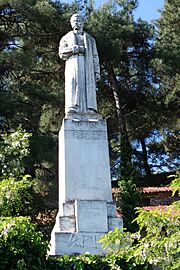
- Tobiah ben Eliezer (11th), author of the Midrash Lekach Tov
- Kasim Baba, 15th century Ottoman Bektashi holy man.
- Sevastos Leontiadis (1690–1765), educationalist
- Konstantinos Michail, scholar
- Georgios Theocharis (1758–1843), merchant, revolutionary and diplomat
- Athanasios Christopoulos (1772–1847), poet
- Emmanuel brothers, partners of Rigas Feraios; executed with him in 1798
- Vasileios Hatzis, painter
- Aristotelis Zachos, architect
- Pavlos Argyriadis (1849–1901), journalist, lawyer and anarchist/socialist intellectual
- Argyrios Vouzas (1857–?), doctor and revolutionary
- Leonidas Papazoglou, photographer
- Şefik Aker (1877–1964), military officer in the Ottoman and Turkish armies
- Nicholas Lambrinides, founder of Skyline Chili, a famous restaurant chain in Cincinnati, USA
- Andreas Tzimas, communist politician
- Lucas Samaras (1936–), artist
- Jagnula Kunovska (1943–), politician, jurist and writer
- Maria Spiropulu (1970–), experimental physicist
- Dimitris Diamantidis (1980–), basketball player
- Ioannis Christou, (1983–), Greek rower
- Christina Giazitzidou (1989–), Olympic bronze medalist in rowing
International relations
Twin towns — sister cities
Kastoria is twinned with:
Gallery
See also
 In Spanish: Kastoriá para niños
In Spanish: Kastoriá para niños



